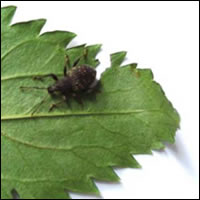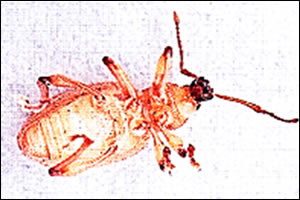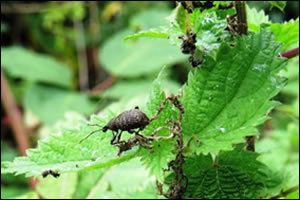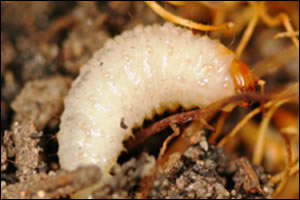VINE WEEVIL
This is the most destructive of the root weevils; most of the damage is done when in its larval form.
- Virtually all vine weevils are female and cannot fly.
- A period of 2 – 3 weeks of feeding occurs before the adult begins to lay eggs. The weevil then alternatively feeds and lays eggs for about a month.
- The damage caused by adult feeding consists of marginal notching of leaves or cut off of needles.
- Find either of these and you have positive evidence of vine weevils.
- They are most active at night - during the day the adult hides in dark places on the stems of very dense plants or in ground litter.
It is the larvae or grub that is truly destructive to plants. Larval feeding starts midsummer when the eggs hatch and continues into autumn, restarting again in spring.
- The feeder roots and the bark on larger roots are eaten by the larvae and this usually results in the death of the plant.
- Pupation occurs in the soil near the surface.
- The pupa is milky white in colour.
- Adults emerge from the soil in June; egg laying starts 2 weeks later.
- Each female lays approx. 500 eggs near the base of the plant over a period of 2 – 3 weeks.
- They hatch in 10 – 14 days and the larvae tunnel into the soil to feed on the roots.
- Vine weevils have now reached epidemic proportions and there are no chemical treatments available to the amateur in the U.K.
- The adult, egg-laying beetles cannot fly so you can take certain measures to prevent them ever reaching your trees. Sticky grease-bands placed around the legs of your benches can help, although vine weevils have long legs with hooked feet that can sometimes help them cross old and worn-out grease bands.
- Covering the ground in your bonsai display area with gravel or pea-shingle creates a surface that vine weevils dislike and are unlikely to cross.
- Standing the feet of your benches in trays of water is an absolute barrier so long as they remain full.
THE TREATMENTS AVAILABLE FOR PESTS ARE NUMEROUS AND WIDE RANGING, INCLUDING CHEMICAL PREPARATIONS, ORGANIC METHODS, AND NEMATODES
- These amazing minute creatures like nothing better than being released in a greenhouse full of tasty morsels.
- The ‘of-the-shelf’ products are changing all the time, so once you have identified the pest, the best thing is to go a local nursery or garden centre and see what they advise.
- Some people seem to have more success with one preparation than another. This may depend on your geographical location and ambiance. Try out various preparations until you come up with the one that is most effective for you.
- Ministry regulations have banned the stronger chemicals from use by private individuals. A friendly farmer or horticulturalist may help you out. The most effective chemical available to us at present is ‘PROVADO’ vine weevil killer






This sequence shows the Vine Weevil from larvae to maturity- the leaf showing the damage that they can cause